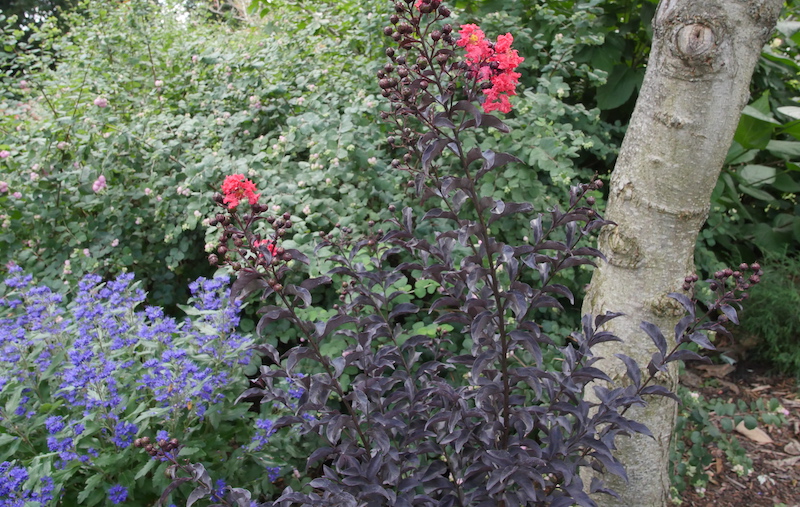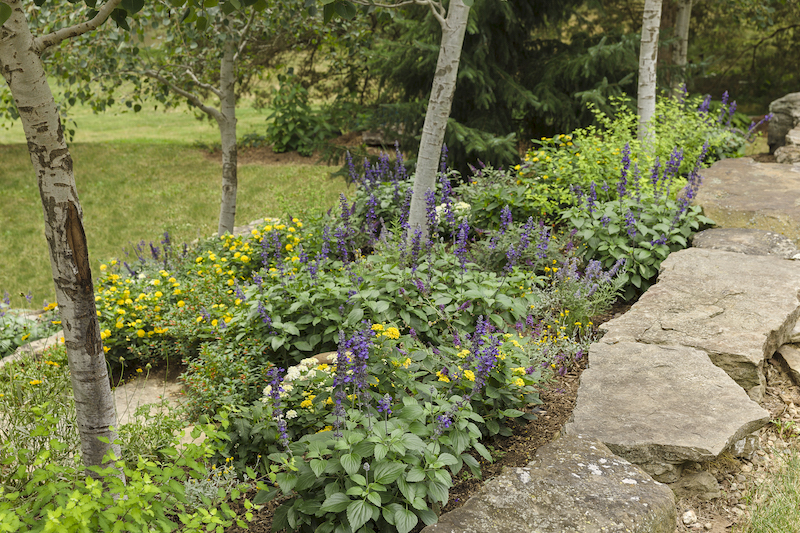Whether you call it bluebeard, blue Spirea, or Caryopteris, there is no denying that this is one valuable shrub for adding late summer color and attracting beneficial pollinators to your garden. Bees, butterflies, moths, and hummingbirds cannot resist the nectar of this drought-tolerant and low-growing shrub. Great plants to combine with bluebeard are other native pollinator shrubs and perennials that are just as easy to care for with almost no annual maintenance.
Plant bluebeard in almost any location in the garden, as long as the soil drains well and is not overly rich in nutrients. Bluebeard will establish well in sandy, rocky, or clay soil, becoming more drought tolerant as it matures.

Shrubs To Plant With Bluebeard
Bluebeard looks good with practically any blooming native shrub. Summersweet, weigela, and elderflower have a loose, mounded shape, like bluebeard, and can be used to form a native hedgerow at the back of a large property or along a fenceline to provide habitat for local wildlife throughout the year. Other ornamental natives such as red twig dogwood, serviceberry, ocean spray, and ninebark can be planted as a backdrop to the lower-growing bluebeard, creating graduated layers in a mixed shrub border.
Perennials To Plant With Bluebeard
Add bluebeard to a pollinator garden for a boost of deep color in the middle of the bed. Taller growing phlox, coneflower, ornamental and native prairie grasses, crocosmia, and windflower make a lovely backdrop for bluebeard. At the front of the border, plant dwarf Russian sage, asters, mums, catmint, salvia, bee balm, and autumn-blooming sedum for varied heights and textures near pathways or sidewalks. These low growers also perform as facer plants for the mid-level plants, hiding any naked stems or die back as the hot weather of summer starts.

Annuals To Plant With Bluebeard
Annuals can be added to a bed of perennials and shrubs for instant color at any time of the year. Early blooming hardy annuals like pansies, violas, calendula, and lobelia will provide color until the Bluebeard shrubs leaf out and bloom. Hot weather plants like the firecracker plant, moss rose, lantana, stone crop, verbena, and zinnias can be planted to highlight the deep colors of the bluebeard flowers and foliage. In warmer growing zones, a fall display of hardy annuals, like violas and mums, can keep color in the garden for as long as the new year.
Best Companion Plants For Bluebeard in Containers
The naturally compact shape of bluebeard makes it a great choice for a mixed seasonal planter on a deck or patio. Use bluebeard as the thriller and add shallow-rooted annuals, such as calibrachoa, licorice plant, lobelia, morning glory, and creeping Jenny, as the filler and spiller elements. The annuals are perfect for highlighting the stunning blue color of bluebeard’s flowers and will not compete with bluebeard for moisture and nutrients.
Ensure the container drains well and contains loose potting mix with extra perlite for drainage. Fertilize the container annually with a light application of a balanced all-purpose feed in the early spring. Regular watering is important to keep all of the plants properly hydrated and should be increased as the plants grow and fill the container.
Plants Not To Grow With Bluebeard
Plants that thrive in full shade or continuously wet soils will not grow well alongside bluebeard. Ferns, hostas, and lilies of the valley require more shade than bluebeard tolerates, while calla lilies and papyrus reed need more moisture than bluebeard can handle. Tropical houseplants may seem like suitable companions for bluebeard, but they require protection from intense sun when moved outdoors to grow. The tender leaves of most tropical plants will burn in hot sun and look best in moist soil, as found in their natural habitats in tropical rainforests.
Best Plants To Grow With Bluebeard
Bluebeard works well in landscape plantings full of easy-to-grow perennials and annuals. Plant it with Russian sage, catmint, and salvia, which mirror the deep blues of bluebeard flowers and add silvery foliage with different textures. Annuals with hot-colored flowers like firecracker plants, moss rose, lantana, and sedum will add long-lasting color to the composition. All of the plants grow best in full sun and will tolerate short periods of drought and high temperatures with no setbacks to their growth.
 |
Author Robbin Small - Published 10-20-2023 |
